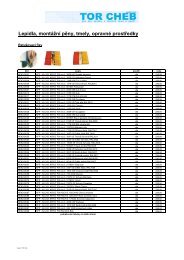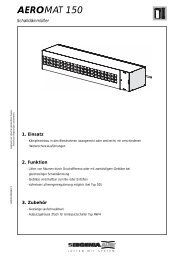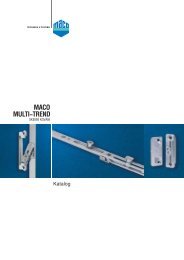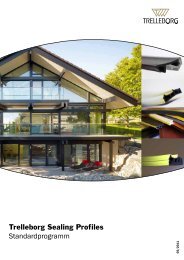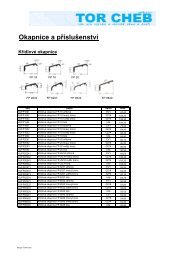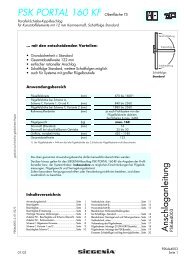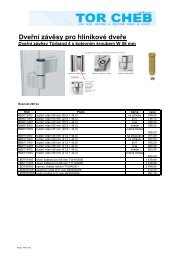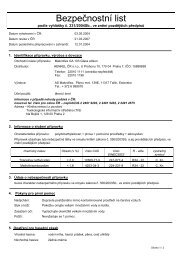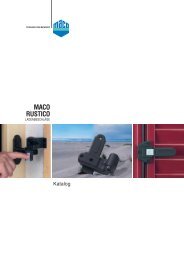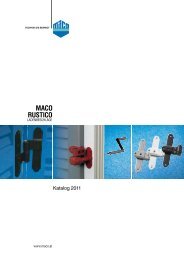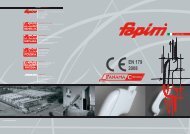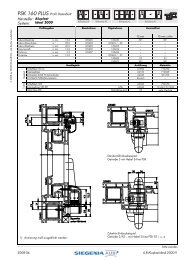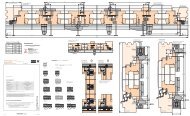Reedkontaktschließteil für Verschlussüberwachung RVS
Reedkontaktschließteil für Verschlussüberwachung RVS
Reedkontaktschließteil für Verschlussüberwachung RVS
Create successful ePaper yourself
Turn your PDF publications into a flip-book with our unique Google optimized e-Paper software.
Maco<br />
tronic<br />
<strong>Reedkontaktschließteil</strong> <strong>für</strong> <strong>Verschlussüberwachung</strong> <strong>RVS</strong><br />
Montageposition <strong>Reedkontaktschließteil</strong> <strong>für</strong> Fenster MULTI - Abstand 5 mm<br />
Montageposition <strong>Reedkontaktschließteil</strong> <strong>für</strong> Türschloss PROTECT MODUL - Abstand 6 mm<br />
Kontaktgeberposition bei ,,Beschlag verriegelt“: Kontaktgeberposition bei ,,Beschlag entriegelt“:<br />
C C<br />
18 mm18 mm 18 mm18<br />
mm<br />
Maß Z max. 5 mm<br />
2,5<br />
1,5<br />
o<br />
1,5<br />
Justierbarkeit<br />
2,5<br />
Z<br />
Z<br />
Schaltabstand<br />
in X (mm)<br />
Schaltabstand<br />
in Y (mm)<br />
Toleranz<br />
(mm)<br />
A 10 17 +/- 2<br />
B 11 20 +/- 3<br />
Installationshinweise <strong>Reedkontaktschließteil</strong> <strong>RVS</strong><br />
Bei der <strong>Reedkontaktschließteil</strong>montage muss <strong>für</strong> das Kabel eine Bohrung von mind. 8,5 mm vorgesehen werden.<br />
Achtung: Beim Verschrauben des <strong>Reedkontaktschließteil</strong>s <strong>RVS</strong> nicht das Kabel beschädigen. Die Kabelenden des <strong>Reedkontaktschließteil</strong>s<br />
<strong>RVS</strong> sind zum Anschluss an die Alarmanlage aus dem Blendrahmen herauszuführen (Zugentlastung in Form einer Schlaufe vorsehen). Für die<br />
Verschraubung sollten weitestgehend antimagnetische Schrauben verwendet werden, wie z. B. V2A-Schrauben!<br />
HUB<br />
(mm)<br />
Abstand in C<br />
(mm)<br />
MULTI 19 5<br />
PROTECT 20 6<br />
A = Näherungs- / Einschaltabstand<br />
B = Entfernungs- / Abschaltabstand<br />
<strong>Reedkontaktschließteil</strong> <strong>RVS</strong> anschließen (siehe Zeichnung)<br />
- Legen Sie die erforderliche Kabellänge (max. 6 m) fest.<br />
- Kabel gegebenenfalls kürzen und Enden abisolieren.<br />
- Messen Sie die Adernbelegung des Anschlusskabels aus (Adernbelegung notieren).<br />
- <strong>Reedkontaktschließteil</strong> <strong>RVS</strong> an Verteiler klemmen.<br />
- Verteiler mit weiteren Elementen, z. B. Schalteinrichtungen verdrahten. Funktion des Meldekontaktes<br />
prüfen.<br />
Hinweis: Die Adern sind gemäß Zeichnung über Kreuz verdrahtet.<br />
Achtung: <strong>Reedkontaktschließteil</strong>e <strong>RVS</strong> können durch zu hohe Spannungen und Ströme beschädigt<br />
werden! Zur Prüfung eignet sich ein handelsübliches Digitalmultimeter mit Durchgangsprüfer.<br />
Niemals einen Glühlampen-Durchgangsprüfer verwenden.<br />
Die technischen Daten des <strong>Reedkontaktschließteil</strong>s <strong>RVS</strong> dürfen nicht überschritten werden.<br />
Technische Daten <strong>RVS</strong><br />
+X<br />
-X<br />
Y<br />
+X<br />
-X<br />
B<br />
A<br />
ACHTUNG! Bei Einzelentnahme muss der<br />
Beipackzettel dem Einzelteil hinzugefügt werden.<br />
Bei Bedarf können Sie den Beipackzettel unter der angeführten<br />
Bestellnummer bei MACO anfordern.<br />
Y<br />
Hinweis Kombination Öffnungs- und <strong>Verschlussüberwachung</strong>:<br />
frühester Einschaltpunkt, wenn sich der Kontaktgeber mind. 50% im<br />
Eingriff des <strong>Reedkontaktschließteil</strong>s <strong>RVS</strong> befindet.<br />
Kontakttyp Schließer<br />
Anschlussart bis 6 m, LIYY 4 x 0,14 mm², Kabel weiß<br />
Schaltleistung max. 10 W / VA<br />
Schaltspannung max. 100 V / DC, max. 70 V / AC<br />
Schaltstrom max. 0,5 A<br />
Dauerstrom max. 0,5 A<br />
Kontaktwiderstand max. 150 mOhm<br />
Spannungsfestigkeit min. 150 V DC<br />
Ansprecherregungsbereich AW 10 - 30<br />
Schutzart IP67<br />
Lebensdauer 10 Mio. Schaltspiele<br />
Temperaturbereich -25° C bis 75° C<br />
VdS-Zulassungen VdS-Klasse C, <strong>Verschlussüberwachung</strong><br />
VdS-Klasse B, Öffnungsüberwachung<br />
VdS-Klasse B, Kombinierte Öffnungs- und <strong>Verschlussüberwachung</strong><br />
EN 50131-2-6 Grad 2<br />
Schutz gegen Umwelteinflüsse VdS Umweltklasse III, nach Richtlinie <strong>für</strong> Einbruchmeldeanlagen<br />
VdS 2110, EN 50131-2-6
Z<br />
ATTENZIONE! In caso di acquisto di pezzi singoli,<br />
allegare le istruzioni di montaggio a ciascun pezzo.<br />
Se necessario potete richiedere copie del foglietto illustrativo a<br />
MACO indicando il relativo numero d’ordine.<br />
Scontro REED per controllo chiusura <strong>RVS</strong><br />
Posizionamento dello scontro REED per finestra MULTI – Distanza 5 mm<br />
Posizionamento dello scontro REED per serratura modulare PROTECT – Distanza 6 mm<br />
Posizione del nottolino magn. con “ferramenta in chiusura”: Posizione del nottolino magn.con “ferramenta in apertura“:<br />
C C<br />
18 mm 18 mm 18 mm 18 mm<br />
2,5<br />
Quota Z max. 5 mm<br />
1,5<br />
o<br />
1,5<br />
Regolazione<br />
2,5<br />
Maco<br />
tronic<br />
Z<br />
corsa<br />
(mm)<br />
Distanza C<br />
(mm)<br />
MULTI 19 5<br />
PROTECT 20 6<br />
A = distanza di avvicinamento/attivazione<br />
B = distanza di allontanamento/disattivazione<br />
Nota: controllo<br />
combinato apertura<br />
e chiusura: il primo<br />
punto di attivazione si<br />
ha quando il nottolino<br />
magnetico si trova<br />
ad essere inserito<br />
per almeno il 50 %<br />
all’interno dello scontro<br />
REED <strong>RVS</strong>.<br />
Istruzioni per il collegamento dello scontro REED <strong>RVS</strong><br />
Per il montaggio dello scontro REED occorre praticare un foro da almeno 8,5 mm di diametro.<br />
Fare attenzione a non danneggiare il cavo durante l’avvitamento. Per collegare le estremità del cavo all’impianto d’allarme, occorre prima farlo<br />
passare attraverso il telaio della finestra (formare un’ansa per garantire un opportuno scarico della trazione). Per l’avvitamento, si dovrebbero<br />
utilizzare solo viti amagnetiche, come per esempio viti inox V2A!<br />
MAYER & CO BESCHLÄGE GMBH<br />
ALPENSTRASSE 173<br />
A-5020 SALZBURG<br />
TEL: +43 (0)662 6196-0<br />
FAX: +43 (0)662 6196-101<br />
maco@maco.at<br />
www.maco.at<br />
+X<br />
-X<br />
Y<br />
+X<br />
-X<br />
B<br />
A<br />
Allacciare lo scontro REED<br />
<strong>RVS</strong> (vedi disegno)<br />
- Determinare la lunghezza del<br />
cavo necessaria (max. 6 m).<br />
- Accorciarlo se necessario, e<br />
spelare le estremità dei fili.<br />
- Rilevare la disposizione dei fili<br />
di contatto (prendere nota della<br />
disposizione).<br />
- Collegare lo scontro REED <strong>RVS</strong><br />
ad una morsettiera.<br />
- Allacciare la morsettiera ad<br />
ulteriori componenti quali p.e.<br />
relè. Verificare il funzionamento<br />
del contatto di segnalazione.<br />
Nota: i fili interni sono disposti<br />
e collegati a croce come da<br />
disegno.<br />
Y<br />
Dati tecnici del <strong>RVS</strong><br />
distanza di funzionamento<br />
X (mm)<br />
distanza di funzionamento<br />
Y (mm)<br />
tolleranza<br />
(mm)<br />
A 10 17 +/- 2<br />
B 11 20 +/- 3<br />
Tipo di contatto in chiusura (normalmente aperto)<br />
Tipo di collegamento fino a 6 m , LIYY 4 x 0,14 mm², cavo<br />
bianco<br />
Potenza di interruzione max. 10W/ VA<br />
Tensione d’esercizio max. 100 V/ DC, max. 70 V/ AC<br />
Corrente in chiusura max. 0,5 A<br />
Corrente permanente max. 0,5 A<br />
Resistenza dei contatti max. 150 mOhm<br />
Rigidità dielettrica min. 150 V DC<br />
Campo di eccitazione<br />
all’intervento<br />
AW 10-30<br />
Classe di protezione IP67<br />
Durata 10 milioni di cicli<br />
Temperatura di esercizio da –25°C a 75°C<br />
Omologazioni VdS Classe C VdS, controllo chiusura<br />
Classe B VdS, controllo apertura<br />
Classe B VdS, controllo combinato<br />
apertura e chiusura<br />
EN 50131-2-6 Grado 2<br />
Protezione dai fattori ambi- VdS, classe ambientale III, in conformità<br />
entali<br />
con la Direttiva sui sistemi di allarme<br />
antintrusione VdS 2110, EN 50131-2-6<br />
Attenzione: gli scontri REED <strong>RVS</strong> possono essere danneggiati da tensioni e correnti elevate! Per eventuali<br />
verifiche utilizzare un comune multimetro digitale con tester di continuità. Non utilizzare mai tester<br />
continuità per lampade ad incandescenza. Non superare mai in valori indicati nei dati tecnici dello scontro<br />
REED <strong>RVS</strong>.<br />
MACO-BESCHLÄGE G.M.B.H., Haidhof 3, D-94508 Schöllnach, Tel.: +49 9903 9323-0, Fax: +49 9903 9323-5099<br />
d-maco@maco.de, www.maco.de<br />
MAICO SRL, Zona Artigianale 15, I-39015 S. Leonardo i. P., Tel.: +39 473 651200, Fax: +39 473 651300<br />
maico@maico.com, www.maico.com<br />
MACO DOOR & WINDOW HARDWARE (U.K.) LTD, Eurolink Industrial Centre, Castle Road, Sittingbourne Kent, ME10 3LY<br />
Tel. +44 (0)1795 433900 Fax +44 (0)1795 433901, enquiry@macouk.net, www.macouk.net<br />
MACO-BESCHLÄGE B.V., Stikkenweg 60, NL-7021 BN Zelhem, Tel.: +31 314 659700, Fax +31 314 623649<br />
info@maco-nl.nl, www.maco-nl.nl<br />
MACO POLSKA SP. Z O.O., PL 44-137 Czekanów k/Gliwic, Ul. Gliwicka 1a, Tel.: +48 (0)32 3050904, Fax: +48(0)32 3050901<br />
maco@demo.pl, www.maco-europe.com<br />
Best.-Nr. 756795 – Datum: April 2011 - Änderungsdatum: Juli 2011<br />
Alle Rechte und Änderungen vorbehalten.



